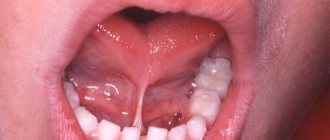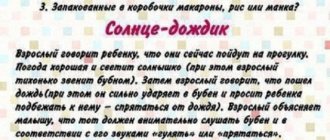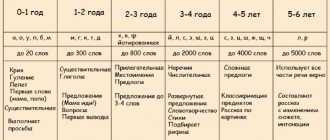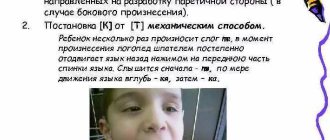Causes of stuttering in speech
Age-related speech imperfections
Repetitions of sound complexes and words are observed in a significant number of children aged 3-5 years. This is a period of active development of coherent utterances and improvement of lexical and grammatical categories.
The accumulation of vocabulary proceeds at a rapid pace, and the child is bombarded with a large flow of sensory information. At the same time, the child’s speech capabilities are still quite limited, mental functions are in the process of formation, and the work of the articulatory apparatus is imperfect. Against this background, physiological hesitations (iterations) develop.
“Stuckness” on individual sounds more often appears in children who are somatically weakened, diagnosed with ADHD, or have a family history of stuttering. Hesitations in a child’s speech can be provoked by a strong emotional shock: quarrels between parents, transfer to another kindergarten, change of place of residence. More often they appear in the off-season, can persist for several weeks or months, disappear and reappear.
Hesitations are non-convulsive in nature and occur anywhere in a word or phrase (usually in words with a complex syllable structure, consonant clusters, or complex sentences). Children repeatedly repeat sounds and their combinations, rearrange syllables, and stumble when pronouncing a phrase. They often speak while inhaling, which causes the speech to be interrupted. The children themselves do not notice their speech defect and treat it calmly.
Typically, physiological hesitations disappear without additional intervention as speech skills improve and HMF develops. It is enough to provide the child with a comfortable emotional environment and the correct speech environment. However, if an incorrect speech stereotype is persistently reinforced, non-convulsive hesitations can develop into convulsive stuttering.
Emotional stress
Speech hesitations are observed in adults due to severe anxiety. Such stumbles are regarded as manifestations of anxiety and a neurotic personality. Stuttering occurs in different situations: during an exam, during a public speech, when meeting new people. The more a person tries to keep the situation under control, to speak clearly and confidently, the more he begins to stammer.
Short-term stutters appear when frightened; in such cases they say that the person “began to stutter out of fear.” However, in all these cases, speech iterations are short-lived and transitory. Speech returns to normal as soon as the stress factor disappears.
Stuttering
Speech spasms are the leading symptom of logoneurosis and neurosis-like stuttering. In this case, an obsessive involuntary repetition of syllables (“ma-ma-shop”) and/or getting stuck on a separate sound (“p-p-rooster”) occurs. Stuttering occurs more often on certain “difficult” sounds ([k], [p], [t]) or sound combinations with a combination of consonants ([kr], [st] [tr]), on stressed and pre-stressed syllables, on the first syllable in word.
Sometimes convulsions manifest themselves in silence, because due to a spasm of the speech muscles the person cannot start a sentence. A person who stutters can feel a speech spasm as the presence of an obstacle in the larynx, compression of the chest, tension in the facial muscles and abdominal muscles. The frequency of stuttering and its duration increases in unfamiliar conditions, in front of strangers.
When stuttering, the pace and rhythm of speech, the unity and smoothness of speech suffer. Speech symptoms are superimposed by secondary neurotic reactions: speech tricks, accompanying movements, vegetative manifestations. Logophobia arises - fear of oral speech. Convulsive hesitations in speech do not disappear on their own, without special therapy.
Tahilalia
Excited speech is characterized by an excessively accelerated pace, dysrhythmic character with sudden stops and subsequent breakthroughs. Stuttering, unintentional repetitions, and swallowing of syllables and words occur. The intelligibility and intelligibility of oral speech is lost. If a patient with tachylalia is pointed out about his speech errors, then hesitations and perseverations temporarily disappear, but the rate of speech still remains fast.
All speech deficiencies manifest themselves especially clearly during excitement, in moments of argument and emotional excitement. In the non-speech sphere, motor restlessness, tics, attention deficit, short temper, and vasomotor reactions are noted. In some cases, speech hesitations with tachylalia develop into a late form of stuttering.
Clattering
Poltern, or cluttering, as a special case of tachylalia, is characterized by non-convulsive interruption of speech against the background of its accelerated pace. This speech disorder is characterized by stumbling, repetitions of sounds and syllables, their omissions, and reversals. Hesitations are manifested by chaotic silent movements of the tongue and lips, and unreasonable pauses in phrases. Due to haste in speech, the endings of words are often “swallowed”, sometimes entire phrases and phrases “fall out”.
With clattering, other aspects of speech activity also suffer: the smoothness and melody of speech is disrupted, there are no logical stops and stresses, a nasal tone of voice appears, and errors appear in writing. The flow of speech is accompanied by restless behavior, grimaces, and absent-mindedness. Due to unintelligibility of speech, verbal communication is difficult, and the defect is not recognized.
Violation of the regulatory mechanisms of the central nervous system
Convulsive hesitations in speech may appear as patients recover from motor alalia, aphasia, and dysarthria. The reason for this phenomenon lies in intensive correctional speech therapy, when the volume and pace of introduction of new speech material does not correspond to the functional capabilities of the brain. Usually repetitions of the last syllables occur, while the patient cannot move on to a new word.
Discoordinated convulsions of articulatory muscles, as a rule, do not transform into pathological stuttering. With the organization of competent correctional and pedagogical assistance, such hesitations are successfully compensated without relapse.
Other reasons
The occurrence of stuttering in speech may be associated with an unfavorable speech environment: the fast pace of speech of parents, imitation of stuttering friends or relatives. In some cases, hesitation occurs secondary to various disorders:
- mental retardation;
- neurological diseases: neuroinfections, central nervous system injuries, Parkinson's disease, chorea, pseudobulbar syndrome;
- mental disorders: oligophrenia, bipolar disorder.
Why does a child stutter?
Among the causes are congenital and acquired factors. Congenital include:
- intrauterine lesions of the nervous system,
- birth injuries,
- having close relatives who stutter.
It is assumed that hereditary burden may be associated with genetically determined weakness of the speech apparatus, as well as with characterological characteristics and temperament.
Among the acquired factors:
- childhood infections,
- acute and chronic somatic diseases,
- diseases and injuries of the central nervous system,
- any types of deviations from normal speech development,
- imitating someone who stutters,
- insufficiently developed facial expressions, motor skills and sense of rhythm,
- acute and long-term psychotraumatic situations,
- pathological education,
- constant conflicts in the family,
- weakening of emotional ties between adults and children.
Typically, stuttering occurs in children 2-6 years old, with boys affected more often than girls, which is due to certain differences in the process of age-related brain development. As you get older, the likelihood of developing stuttering decreases. In older children, stuttering usually becomes less severe, but may worsen during puberty.
Diagnostics
The appearance of speech hesitations is a reason to immediately seek the advice of a speech therapist. The sooner their cause and nature are established, the more effective the therapeutic and corrective effect will be. Diagnostics consists of three blocks:
- Speech therapy examination.
Includes the study of oral speech, its tempo-rhythmic and intonation-melodic organization. The type of hesitation and the conditions for its occurrence are determined. The characteristics of voice and breathing are assessed. The task of speech therapy diagnostics is to differentiate non-convulsive hesitations from stuttering. - Neurological examination.
A consultation with a neurologist involves studying the medical history, identifying neuropsychic disorders and factors that caused the patient to hesitate in his speech. In order to exclude brain pathology, instrumental techniques are prescribed: EEG, EchoEG, cerebral MRI. - Psychological examination.
An analysis of the HMF is carried out: attention, memory, thinking. At this stage of diagnosis, attention is paid to the state of general and manual motor skills, various types of praxis, and gnosis. The patient’s personal characteristics, his reaction to his defect, and the presence of fear of speech are analyzed.
How we work with stuttering
To successfully eliminate stuttering, it is necessary to identify its cause and, if possible, eliminate the factors that provoke and support this speech disorder. Therefore, it is necessary that the child receives consultation not only from a speech therapist, but also from a psychotherapist and psychologist. Based on the results of diagnosing the child’s current condition and the suspected causes of stuttering, various diagnostic and therapeutic measures are prescribed (for example, a Neurotest blood test, EEG, pathopsychological and neuropsychological diagnostics).
In the treatment of children suffering from neurotic stuttering, in addition to speech therapy sessions, psychological correction and psychotherapy are mandatory and basic. Various relaxation techniques, art therapy, sand and play therapy, MIM therapy, and group therapy are used. For neurosis-like stuttering, supportive drug therapy is prescribed.
At the reception, our specialists will create the most comfortable atmosphere for the child so that the classes are most effective. And using a combined therapeutic approach will allow you to achieve lasting results!
The specialist will also determine the need for family-parent consultations, help analyze family relationships and see something very important, something that cannot be seen while inside the family system.
Treatment
Mode
If hesitations in a child’s speech are physiological in nature, it is necessary to organize an optimal general and speech regime: ensure sufficient daytime and night sleep, increase the time of walks in the fresh air. It is important to temporarily limit the flow of new information, minimize watching TV, computer games, and attending public events. In verbal communication, the following recommendations must be followed:
- do not focus the child’s attention on hesitations, do not ask him to repeat the word again;
- talk to the child calmly, quietly, a little slower than usual;
- use short phrases, simple words;
- practice singing, learn age-appropriate poetry with tapping rhythm or marching.
Psychological correction
Indicated for patients with emotional hesitations in speech, stuttering, tachylalia, and polternium. This direction of correctional work helps to reduce fixation on a speech defect, eliminate logophobia, mastery of new self-regulation mechanisms, and expand communication capabilities. The main methods of psychocorrectional work are sessions of psychotherapy and hypnosis, communication training, autogenic training.
Speech therapy correction
Taking into account the reasons underlying speech hesitations, classes are conducted on speech development, stuttering correction, overcoming tachylalia, etc. Logotherapy is aimed at developing a new speech stereotype and consolidating it in all communicative situations. The following methods and techniques are used in the work:
- Articulation gymnastics.
Exercises help strengthen the muscles of the speech apparatus, relieve excessive muscle tension during phonation, make articulatory movements more accurate, and form the necessary kinesthesia. Exercises are used for the muscles of the tongue, lips, palate, and facial muscles. Voice gymnastics promotes the development of voice strength and prosodic components. - Breathing exercises.
Correct speech breathing is the key to free, smooth speech. During the classes, diaphragmatic lower costal breathing is performed. Mastering the technique of speech breathing allows you to pronounce phrases of varying lengths without hesitation or pauses. - Speech therapy rhythm.
Logorhythmic exercises help normalize the tempo and rhythm of speech, synchronize breathing and articulation, and develop general motor skills. Classes are held with musical accompaniment. To practice the rhythm, marching, clapping, and jumping are used. - Classes using ICT.
Computer technologies are widely used in comprehensive work to overcome stuttering. They are based on the effect of biofeedback, help improve the quality and emotional coloring of speech, and eliminate hesitations.
Wellness activities
They are organized on the basis of a clinic or day neurological hospital. The goal is to normalize the regulatory function of the central nervous system and increase adaptation mechanisms. Patients with pathological hesitations in speech are prescribed:
- courses of drug therapy (sedatives, B vitamins, nootropics, anticonvulsants):
- physiotherapeutic procedures (electrophoresis with antispasmodics, electrosleep);
- water procedures (coniferous, carbon dioxide, oxygen baths, recreational swimming);
- massage (general medical, neurosedative, SHV);
- acupuncture;
- physiotherapy.








